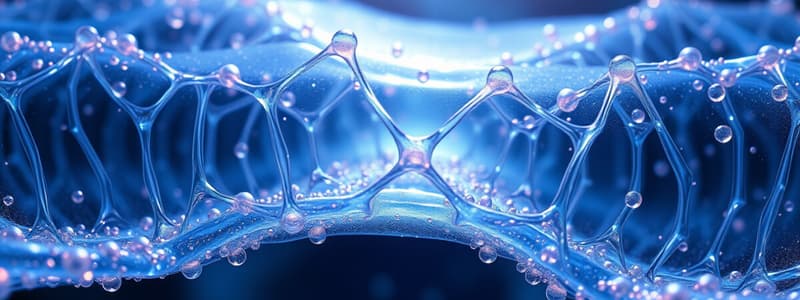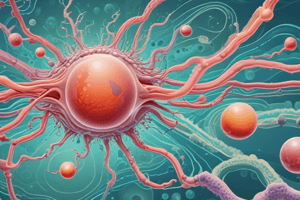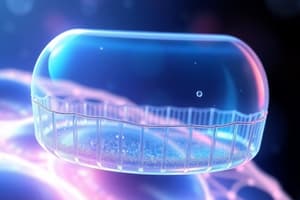Podcast
Questions and Answers
What is a phospholipid composed of?
What is a phospholipid composed of?
A hydrophobic tail and a hydrophilic head.
Which statement is true about hydrophilic heads?
Which statement is true about hydrophilic heads?
- They have a positive charge and repel water.
- They are found on the inner layer of the membrane.
- They are nonpolar.
- They have a negative charge and attract water. (correct)
What characterizes hydrophobic tails?
What characterizes hydrophobic tails?
Fatty acids are nonpolar and hydrophobic.
What role does cholesterol play in the membrane?
What role does cholesterol play in the membrane?
What are peripheral proteins?
What are peripheral proteins?
What are integral proteins?
What are integral proteins?
What is the function of glycoproteins?
What is the function of glycoproteins?
_________ of the cytoskeleton provide structural support inside the cell.
_________ of the cytoskeleton provide structural support inside the cell.
Flashcards
Phospholipid composition
Phospholipid composition
A phospholipid has a hydrophobic tail and a hydrophilic head.
Hydrophilic head property
Hydrophilic head property
Hydrophilic heads have a negative charge and attract water.
Hydrophobic tail characteristic
Hydrophobic tail characteristic
Fatty acid tails are nonpolar and hydrophobic.
Cholesterol's membrane role
Cholesterol's membrane role
Signup and view all the flashcards
Peripheral protein location
Peripheral protein location
Signup and view all the flashcards
Integral protein function
Integral protein function
Signup and view all the flashcards
Glycoprotein function
Glycoprotein function
Signup and view all the flashcards
Cytoskeleton support
Cytoskeleton support
Signup and view all the flashcards
Study Notes
Phospholipid Bilayer Components
- Phospholipids consist of a hydrophobic tail (fatty acids) and a hydrophilic head (phosphate group).
- Hydrophilic heads have a negative charge, allowing them to attract and interact with water molecules.
- Hydrophobic tails are nonpolar, making them repellent to water and promoting bilayer formation.
Membrane Stability and Function
- Cholesterol is integrated within the bilayer, ensuring membrane fluidity and preventing the fatty acid tails from clumping together, particularly in colder temperatures.
- Peripheral proteins are located on the exterior or interior surfaces of the membrane, playing roles in signaling and structural support.
- Filaments of the cytoskeleton provide structural support to the cell and maintain the shape of the plasma membrane.
Protein Types in the Bilayer
- Integral proteins span the entire membrane, facilitating various functions including transport across the bilayer.
- Glycoproteins consist of a carbohydrate chain attached to a protein, serving as identification markers for cell recognition and signaling.
Studying That Suits You
Use AI to generate personalized quizzes and flashcards to suit your learning preferences.
Description
Test your knowledge of the phospholipid bilayer anatomy with this interactive quiz. Learn about the key components such as hydrophilic heads, hydrophobic tails, and cholesterol functionality. Perfect for biology students looking to reinforce their understanding of cell membrane structures.




